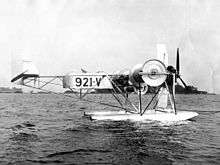Flettner airplane

A flettner airplane is a type of rotor airplane which uses a Flettner rotor to provide lift. The rotor comprises a spinning cylinder with circular end plates and, in an aircraft, spins about a spanwise horizontal axis. When the aircraft moves forward the Magnus effect creates lift.[1]
Anton Flettner, after whom the rotor is named, used it successfully as the sails of a ship, and also projected a Flettner airplane. There is no record of it having been made.
The Butler Ames Aerocycle was built in 1910 and tested on board a warship. There is no record of it having flown.[1][2]
The Plymouth A-A-2004 was built for Zaparka in 1930 by three anonymous American inventors, and was reported to have made successful flights over Long Island Sound.[1][2]
An inherent safety concern is that if power to the rotating drums was lost—even if thrust was maintained—the aircraft would lose its ability to generate lift as the drum slowed down and it would not be able to sustain flight.[3]
See also
References
- 1 2 3 "Whirling Spools Lift This Plane". Popular Science Monthly: 26. November 1930. Retrieved 8 November 2012.
- 1 2 Seifert, Jost; "A Review of the Magnus Effect in Aeronautics", Progress in Aerospace Sciences Vol. 55, Elsevier, 2012, pages 17–45.
- ↑ Ray, Keith (2015). The Strangest Aircraft Of All Time. Stroud, Gloucestershire GL5 2QG: The History Press. p. 48. ISBN 9780750960977.
| Wikimedia Commons has media related to Flettner aircraft. |